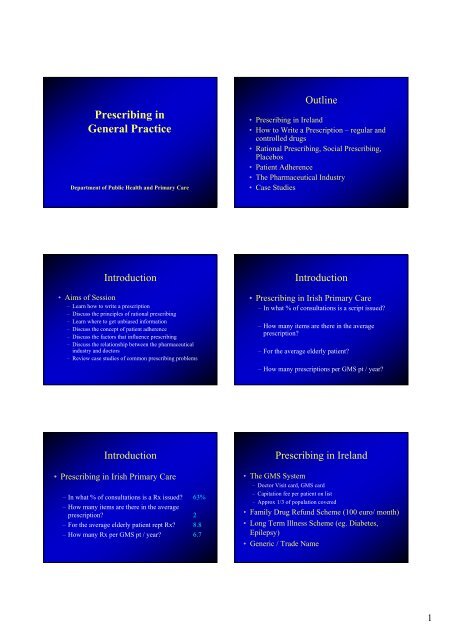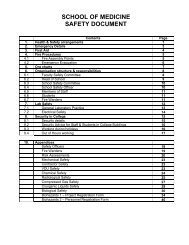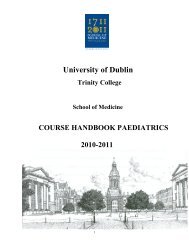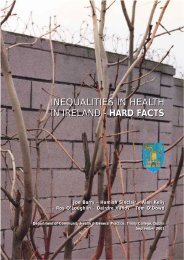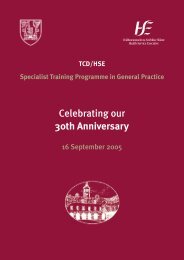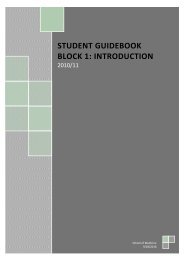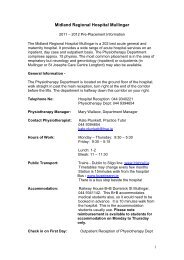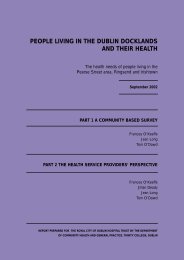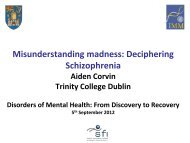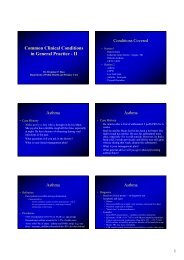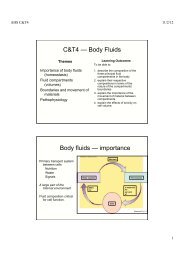Prescribing in General Practice
Prescribing in General Practice
Prescribing in General Practice
Create successful ePaper yourself
Turn your PDF publications into a flip-book with our unique Google optimized e-Paper software.
<strong>Prescrib<strong>in</strong>g</strong> <strong>in</strong><br />
<strong>General</strong> <strong>Practice</strong><br />
Department of Public Health and Primary Care<br />
Outl<strong>in</strong>e<br />
• <strong>Prescrib<strong>in</strong>g</strong> <strong>in</strong> Ireland<br />
• How to Write a Prescription – regular and<br />
controlled drugs<br />
• Rational <strong>Prescrib<strong>in</strong>g</strong>, Social <strong>Prescrib<strong>in</strong>g</strong>,<br />
Placebos<br />
• Patient Adherence<br />
• The Pharmaceutical Industry<br />
• Case Studies<br />
Introduction<br />
• Aims of Session<br />
– Learn how to write a prescription<br />
– Discuss the pr<strong>in</strong>ciples of rational prescrib<strong>in</strong>g<br />
– Learn where to get unbiased <strong>in</strong>formation<br />
– Discuss the concept of patient adherence<br />
– Discuss the factors that <strong>in</strong>fluence prescrib<strong>in</strong>g<br />
– Discuss the relationship between the pharmaceutical<br />
<strong>in</strong>dustry and doctors<br />
– Review case studies of common prescrib<strong>in</strong>g problems<br />
Introduction<br />
• <strong>Prescrib<strong>in</strong>g</strong> <strong>in</strong> Irish Primary Care<br />
– In what % of consultations is a script issued<br />
– How many items are there <strong>in</strong> the average<br />
prescription<br />
– For the average elderly patient<br />
– How many prescriptions per GMS pt / year<br />
Introduction<br />
• <strong>Prescrib<strong>in</strong>g</strong> <strong>in</strong> Irish Primary Care<br />
– In what % of consultations is a Rx issued 63%<br />
– How many items are there <strong>in</strong> the average<br />
prescription 2<br />
– For the average elderly patient rept Rx 8.8<br />
– How many Rx per GMS pt / year 6.7<br />
<strong>Prescrib<strong>in</strong>g</strong> <strong>in</strong> Ireland<br />
• The GMS System<br />
– Doctor Visit card, GMS card<br />
– Capitation fee per patient on list<br />
– Approx 1/3 of population covered<br />
• Family Drug Refund Scheme (100 euro/ month)<br />
• Long Term Illness Scheme (eg. Diabetes,<br />
Epilepsy)<br />
• Generic / Trade Name<br />
1
Generic v. Brand Names<br />
• Generic <strong>Prescrib<strong>in</strong>g</strong><br />
– Usually cheaper<br />
– Less confusion (most of the time)<br />
– Generic names are <strong>in</strong>ternational – clear exchange of<br />
<strong>in</strong>formation<br />
In Ireland, at present:<br />
– Private patients: pharmacist not obliged to give<br />
cheapest formulation if GP prescribes generically<br />
– GMS patients: government and pharmacists have<br />
agreed prices for various drugs<br />
– Future changes<br />
Generic v. Brand Names<br />
• Brand Name <strong>Prescrib<strong>in</strong>g</strong><br />
– Supports research and development by<br />
pharmaceutical companies<br />
– Familiarity for patients May prejudice<br />
adherence<br />
– Brand names usually shorter, and easier to<br />
remember<br />
– Usually more expensive than generic<br />
– Protected period follow<strong>in</strong>g drug launch: Patent<br />
lasts for 10 years (usually) then comes “offlicence”<br />
Rational <strong>Prescrib<strong>in</strong>g</strong><br />
• Aims of Good <strong>Prescrib<strong>in</strong>g</strong><br />
– Maximise effectiveness<br />
– M<strong>in</strong>imise risk<br />
– M<strong>in</strong>imise cost<br />
– Patient centred<br />
Rational <strong>Prescrib<strong>in</strong>g</strong><br />
• What is it<br />
– <strong>Prescrib<strong>in</strong>g</strong> conforms to consensus op<strong>in</strong>ion of the<br />
current best practice<br />
• How to Prescribe Rationally<br />
– Choice of drug is <strong>in</strong>fluenced by several considerations:<br />
• 1. Is the diagnosis known (HTN v. muscular ach<strong>in</strong>g)<br />
• 2. Is a drug required<br />
• 3. Will it work<br />
• 4. Will it harm the patient<br />
• 5. How much will it cost (see next slide)<br />
• 6. Have all the alternatives been considered<br />
• 7. Is the likely benefit : risk ratio acceptable<br />
Rational <strong>Prescrib<strong>in</strong>g</strong><br />
• Cost of Medication<br />
– Antihypertensives:<br />
• Bendroflumethiazide 2.5mg (100 tabs) - €5<br />
• Atenolol 50mg (30 tabs) - €4.93<br />
• Lis<strong>in</strong>opril 5mg (30 tabs) - €10.31<br />
• Per<strong>in</strong>dopril 5mg (30 tabs) - €18.46<br />
• Candesartan 8mg (28 tabs) - €21.56<br />
– Stat<strong>in</strong> – e.g. pravastat<strong>in</strong><br />
• Lipostat 20mg (28 tabs) - €43.44<br />
• Pravamel 20mg (30 tabs) - €37.58<br />
– Nu-Seals Aspir<strong>in</strong> 75mg (28 tabs) - €2.24<br />
Rational <strong>Prescrib<strong>in</strong>g</strong><br />
• The Responsible Prescriber<br />
– Several duties:<br />
• To ensure that the diagnosis is correct<br />
• To make a positive and correct decision that a drug is<br />
needed, and to know enough about the chosen drug<br />
• To choose a drug appropriate to the patient’s needs<br />
• To consult the patient, and to ensure there is<br />
<strong>in</strong>formed consent<br />
• To expla<strong>in</strong> the patient’s role and to secure his / her<br />
cooperation<br />
• To oversee the course of treatment<br />
• To term<strong>in</strong>ate it when it is no longer needed<br />
2
Rational <strong>Prescrib<strong>in</strong>g</strong><br />
• What do you need before writ<strong>in</strong>g a<br />
prescription<br />
– Cl<strong>in</strong>ical skills<br />
– Knowledge of therapeutics (sources of<br />
<strong>in</strong>formation)<br />
– Communication skills (education, adherence)<br />
Keep<strong>in</strong>g Up To Date<br />
• Sources of Objective Information on Medications<br />
– <strong>Practice</strong> formulary<br />
– Other formularies – MIMS, BNF<br />
– Summary of Product Characteristics (www.medic<strong>in</strong>es.ie)<br />
– Peer-reviewed journals<br />
– Drugs and Therapeutics Bullet<strong>in</strong> (NHS)<br />
– National Medic<strong>in</strong>es Information Centre (NMIC: SJH website)<br />
– Irish Medic<strong>in</strong>es Board (IMB) (www.imb.ie)<br />
– Guidel<strong>in</strong>es – e.g. NICE<br />
How to Write a Prescription<br />
• Write a prescription for a simple analgesic.<br />
How to Write a Prescription<br />
• Must Conta<strong>in</strong>:<br />
– Date<br />
– Doctor’s details (or the <strong>in</strong>stitution where s/he works)<br />
– Patient<br />
• Name<br />
• Address<br />
• Age if
How to Write a Prescription<br />
• Abbreviations<br />
– O.D. Omni die<br />
– B.D. Bis die<br />
– T.D.S. Ter die sumendus<br />
– Q.D.S. Quarter die sumendus<br />
– P.R.N. Pro re nata<br />
– Nocte / Mane / Tarde<br />
– P.O. Per orum<br />
– P.R. Per rectum<br />
– I.M. Intramuscular<br />
– STAT<br />
How to Write a Prescription<br />
• Category II Drugs – Schedule of Controlled Drugs<br />
– Schedule 1<br />
• Common illicit substances with no medic<strong>in</strong>al effects – LSD, cannabis,<br />
coca leaf. They cannot be generally prescribed.<br />
– Schedule 2<br />
• Most opiate analgesics – their use is characterised by the care required to<br />
achieve a balance between their def<strong>in</strong>ite cl<strong>in</strong>ical benefits, and their<br />
potential for abuse. E.g. morph<strong>in</strong>e sulphate, physeptone, hero<strong>in</strong>, coca<strong>in</strong>e.<br />
– Schedule 3<br />
• Some sedatives e.g. midazolam and temazepam, strong analgesics,<br />
barbiturates<br />
– Schedule 4<br />
• Most other sedatives belong<strong>in</strong>g to the BZ group. Other drugs with a<br />
reduced content of barbiturates<br />
– Schedule 5 (m<strong>in</strong>imal potential for abuse)<br />
How to Write a Prescription<br />
• Controlled Drug Prescription<br />
– Must be handwritten, not typed / computer pr<strong>in</strong>ted<br />
– The drug formulation must be specified – tablets, syrup etc<br />
– Strength and quantity of the medication must be prescribed <strong>in</strong><br />
words and figures<br />
• E.g: morph<strong>in</strong>e slow release tablets 10 mg (ten milligrams); mitte 60<br />
(sixty) tablets<br />
– Cannot be repeated, and must be dispensed with<strong>in</strong> 14 days<br />
Influences on <strong>Prescrib<strong>in</strong>g</strong><br />
• Despite the known tenets of rational prescrib<strong>in</strong>g,<br />
doctors often prescribe without proof of efficacy –<br />
Why<br />
– Doctor Reasons<br />
• True variations <strong>in</strong> medical op<strong>in</strong>ion (Germany 154,000 Rx for HTN<br />
per 1M pop; UK much less)<br />
• The pressure of pharmaceutical advertis<strong>in</strong>g<br />
• Habit, peer group recommendation and ignorance<br />
• F<strong>in</strong>ancial considerations<br />
– Patient Reasons<br />
• Patient demands / expectations (usually overestimated – a larger %<br />
leave with a Rx than expected one. Up to 20% of pts don’t fill Rx)<br />
• F<strong>in</strong>ancial considerations<br />
• Patient knowledge (armed with reams of <strong>in</strong>fo off the Internet)<br />
• GMS v. private (Ireland)<br />
Influences on <strong>Prescrib<strong>in</strong>g</strong><br />
• Social Reasons<br />
– To play for time (until true picture becomes clearer or natural<br />
recovery occurs)<br />
– To cover uncerta<strong>in</strong>ty, rather than admit it<br />
– Medico-legal worries<br />
– To keep faith with patients, to justify their efforts, and to<br />
demonstrate concern<br />
– To avoid confrontation<br />
– To end a consultation<br />
– To keep faith with partners (“Friday afternoon ABx”)<br />
– Attempt at “placebo prescrib<strong>in</strong>g”<br />
– Many patients are adept at secur<strong>in</strong>g social prescriptions –<br />
barga<strong>in</strong><strong>in</strong>g, <strong>in</strong>sistence, flattery, comparison with other doctors<br />
Placebo <strong>Prescrib<strong>in</strong>g</strong><br />
• Placebo Response<br />
– 30-40% response rate<br />
– In some studies, certa<strong>in</strong> personality traits (e.g. sociability,<br />
neuroticism) identify those that respond better<br />
– In other studies there is no l<strong>in</strong>k to personality, and they feel that<br />
most people can respond given the correct situation<br />
– Males tend to respond more frequently than females and higher<br />
SEG’s are especially prone<br />
– Not entirely a psychological response: physiological changes<br />
have been observed – lowered blood sugars, lowered BP,<br />
reduced cholesterol (and CVD mortality <strong>in</strong> one study!)<br />
– Their time-response mimics pharmacok<strong>in</strong>etics of active drugs<br />
– Up to 40% of patients experience side fx<br />
4
Placebo <strong>Prescrib<strong>in</strong>g</strong><br />
• Factors Affect<strong>in</strong>g Placebo Response<br />
– Pa<strong>in</strong> levels – more severe means response more likely<br />
– Anxiety levels<br />
– Tablet size, appearance and formulation. Effective placebos are:<br />
• Either very large or very small<br />
• Unlike an everyday medication <strong>in</strong> appearance<br />
• Capsules / <strong>in</strong>jections rather than tablets<br />
• Bitter to taste<br />
• Colour is also important<br />
– Patient expectation<br />
– High technology: attendance at OPD, X-rays and especially<br />
<strong>in</strong>vasive <strong>in</strong>vxns have a therapeutic effect<br />
– Conviction and charisma of prescriber<br />
Placebo <strong>Prescrib<strong>in</strong>g</strong><br />
• Effect of Drug Colour on Placebo Response<br />
– Colour Best Response In<br />
– Blue / green Creams / o<strong>in</strong>tments<br />
– Green Anxiety<br />
– Red Analgesia<br />
– Red / brown Elixirs<br />
– Yellow Depression<br />
Placebo <strong>Prescrib<strong>in</strong>g</strong><br />
• Ethical Problems<br />
– For:<br />
• It is effective (does the mechanism matter if the result is satisfactory)<br />
• It is reassur<strong>in</strong>g and helps morale <strong>in</strong> chronic / <strong>in</strong>curable disease<br />
• It fulfils patient expectations<br />
• There is no significant toxicity<br />
• There is evidence of an underly<strong>in</strong>g physical basis (e.g. naloxone has been<br />
shown to reverse placebo-<strong>in</strong>duced pa<strong>in</strong> relief - endorph<strong>in</strong>-based mech)<br />
– Aga<strong>in</strong>st<br />
• It is deception and an abuse of a relationship of mutual trust<br />
• It may generate hurt and ill-feel<strong>in</strong>g if the deception is uncovered<br />
• It delays true diagnosis<br />
• It re<strong>in</strong>forces the sick role<br />
Self-Medication<br />
– Conscious effort <strong>in</strong> last decade to <strong>in</strong>crease range of drugs<br />
available OTC. Drugs can be reclassified as OTC provided they<br />
are safe, of low toxicity <strong>in</strong> OD and used only for “m<strong>in</strong>or” selflimit<strong>in</strong>g<br />
conditions<br />
• Advantages<br />
– Opportunity for pts to take more responsibility for their health<br />
– Can save cost, <strong>in</strong>convenience and time <strong>in</strong> gett<strong>in</strong>g a Rx<br />
– Can ease pressures on surgery appts<br />
Self- Medication<br />
• Disadvantages<br />
– Increased risk of drug <strong>in</strong>teraction with prescription meds<br />
– Increased risk of self-medication of side fx<br />
– Risk of <strong>in</strong>appropriate self medication<br />
• Serious illness – may mask / delay presentation<br />
• Tak<strong>in</strong>g the wrong preparation / formulation<br />
• Tak<strong>in</strong>g the wrong dose (or the right dose for too short / long)<br />
– Risk of generat<strong>in</strong>g a “pills for all ills” culture <strong>in</strong> consumers<br />
– Less feedback on adverse drug rxns<br />
– Less chance to offer opportunistic health promotion activities<br />
Doctors need to always ask patients about their use of OTC and<br />
alternative medications, and educate patients on their safe use<br />
Adherence (Compliance)<br />
• The Problem of Non-Adherence (Concordance)<br />
– 1/3 of patients take their drugs exactly as prescribed<br />
– 1/3 take their drugs, but not exactly as prescribed<br />
– 1/3 do not take their drugs<br />
– 50% of the time patient adherence is sufficient to ga<strong>in</strong><br />
therapeutic benefit…….50% of the time it is not<br />
• Conscious / unconscious<br />
• Reflects communication<br />
• Doctor controls prescrib<strong>in</strong>g, but patient controls use<br />
5
Adherence<br />
• Factors Affect<strong>in</strong>g Adherence (Patient / Doctor Factors)<br />
– Understand<strong>in</strong>g of the <strong>in</strong>structions<br />
• Age of patient<br />
• Educational level of patient<br />
• Complexity of regimen etc. (e.g. COCP, bisphosphonates)<br />
– Quality of doctor-patient <strong>in</strong>teraction<br />
– Family and social isolation<br />
– Beliefs, attitude and personality<br />
• Health belief model<br />
• Locus of control<br />
• Ego strength<br />
• Drug aversion<br />
Adherence<br />
• Factors Affect<strong>in</strong>g Adherence (Illness / Medication<br />
Factors)<br />
– Number of medications prescribed concurrently<br />
– Nature of illness<br />
• Asymptomatic<br />
• Psychiatric<br />
• Chronic<br />
– Use of medic<strong>in</strong>e for prevention rather than treatment<br />
– Number of troublesome side fx with the medic<strong>in</strong>e<br />
– Duration of therapy<br />
Adherence<br />
• Ways to Improve Adherence<br />
– Involve the patients and carers <strong>in</strong> the management<br />
– Choose the simplest regime possible<br />
• E.g. once weekly dos<strong>in</strong>g for bisphosphonates<br />
– Discuss the rationale fully<br />
– Simple written <strong>in</strong>structions<br />
– Review risk : benefit balance<br />
– Consider alternatives<br />
– Use expertise of local pharmacist<br />
– Monitor treatment<br />
• Review regularly re side fx etc. and adjust regime accord<strong>in</strong>gly<br />
Adherence<br />
• What should patients be told about their medication<br />
– The name of the medic<strong>in</strong>e<br />
– What it is for<br />
– How it works (or is thought to work)<br />
– Whether it is essential, important, or optional<br />
– How much to take, how to take, how often to take it and how<br />
long to take it for<br />
– What benefits to expect<br />
– What adverse effects might occur<br />
• Legal obligation to tell patients about common side fx and those that are<br />
potentially serious (even if rare) – <strong>in</strong>formed consent<br />
– What to do if no benefit, or less than expected benefit<br />
– What to do if adverse effects occur<br />
Special Circumstances<br />
• Special considerations are needed when prescrib<strong>in</strong>g for<br />
the follow<strong>in</strong>g patient groups:<br />
– The elderly<br />
– Children<br />
– Pregnant (or potentially pregnant) women<br />
– Breast-feed<strong>in</strong>g women<br />
– Term<strong>in</strong>al care<br />
– Co-exist<strong>in</strong>g medical conditions e.g. renal / liver failure<br />
– Particular drug categories e.g. warfar<strong>in</strong><br />
The Pharmaceutical Industry<br />
• Relationship between the Pharmaceutical Industry<br />
and doctors has come under <strong>in</strong>creas<strong>in</strong>g scrut<strong>in</strong>y<br />
– Irish Medical Council issued guidel<strong>in</strong>es <strong>in</strong> 2004<br />
• “Non-promotional educational grants represent the only<br />
acceptable mechanism of f<strong>in</strong>ancial support by the<br />
pharmaceutical and medical manufactur<strong>in</strong>g <strong>in</strong>dustries to<br />
<strong>in</strong>dividual doctors”<br />
– Pros:<br />
• The <strong>in</strong>dustry conducts almost all the research and<br />
development <strong>in</strong>to new drugs, that goes on <strong>in</strong> the world<br />
• Provide <strong>in</strong>formation and education to healthcare workers<br />
• Support the economy<br />
6
The Pharmaceutical Industry<br />
• Cons:<br />
– Doctors prescrib<strong>in</strong>g is <strong>in</strong>fluenced by their <strong>in</strong>teractions with the <strong>in</strong>dustry –<br />
even down to accept<strong>in</strong>g simple gifts like pens etc (sense of obligation,<br />
familiarity with drug)<br />
– Doctors consistently underestimate how much this <strong>in</strong>fluence affects them<br />
personally<br />
– Patients generally are not aware of the l<strong>in</strong>ks between doctors and the<br />
<strong>in</strong>dustry. Studies have shown that when they f<strong>in</strong>d out, they do not approve<br />
– Studies conducted by pharmaceutical companies are often only published if<br />
the results are positive for them<br />
– Information from reps can be <strong>in</strong>accurate – one study found that 11% of<br />
statements made by reps directly contradicted the known facts about a drug<br />
(<strong>in</strong>clud<strong>in</strong>g their own promotional material)<br />
– The pharmaceutical <strong>in</strong>dustry spends billions of euro a year on market<strong>in</strong>g to<br />
doctors – because it works<br />
– Ref: www.nofreelunch.org BMJ 2003;326 31 st May (feature edition)<br />
Case Studies<br />
• 2 y.o. girl<br />
– Fever and refus<strong>in</strong>g all food and dr<strong>in</strong>k x 24 hours<br />
– Severe tonsillitis<br />
Case Studies<br />
• 17 y.o. boy<br />
– Fever and unable to take food and dr<strong>in</strong>k x 24 hours<br />
– Severe tonsillitis<br />
Case Studies<br />
• 47 y.o. man<br />
– BP 168/96<br />
– What do you want to know<br />
– Would you treat him<br />
– What would you use<br />
Case Studies<br />
• 79 y.o. lady <strong>in</strong> nurs<strong>in</strong>g home, asked to come and r/v re<br />
dizz<strong>in</strong>ess and recurrent falls<br />
– Medications<br />
• Madopar 250 QID (levodopa 200mg + benserazide 50mg)<br />
• Digox<strong>in</strong> 0.125mg BD<br />
• Allopur<strong>in</strong>ol 200mg BD<br />
• Frusemide 20mg BD<br />
• Thioridaz<strong>in</strong>e 50mg TID<br />
• Amitryptill<strong>in</strong>e 75mg nocte<br />
• Nitrazepam 5mg nocte<br />
– What might be the <strong>in</strong>dications for these medications<br />
– What are their common adverse effects<br />
– Are any of them likely to be contribut<strong>in</strong>g to her symptoms<br />
– How would you alter her medication.<br />
7
Case Studies<br />
• 50 y.o. male<br />
– Presents with acute muscle spasm of back<br />
– PMHx – mild hypertension, ang<strong>in</strong>a, gout<br />
– Medications<br />
• Aspir<strong>in</strong> 75mg OD<br />
• Centyl K (bendroflumethiazide + K+) 2.5mg OD<br />
• Allopur<strong>in</strong>ol 300mg OD<br />
– What would you consider prescrib<strong>in</strong>g<br />
– Would you have any concerns about his current Rx<br />
Case Studies<br />
• 15 y.o. girl, unaccompanied<br />
– Wants to go on the oral contraceptive pill<br />
– How would you proceed<br />
– What are the ethical issues raised<br />
Conclusion<br />
• Apply cl<strong>in</strong>ical and communication skills<br />
• Apply the pr<strong>in</strong>ciples of rational prescrib<strong>in</strong>g<br />
• Search for objective sources of <strong>in</strong>formation on<br />
medications<br />
• Take steps to maximise adherence<br />
• Review and monitor<br />
8


